Dioscorea bulbifera L. (air-potato
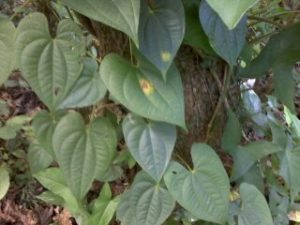

Dioscorea bulbifera was introduced in 1905 as a potential agricultural crop and for its medicinal purposes (Invasive Plant Atlas, MacDonald et al. 2008). It is native to Africa, Asia and Australia (Starr et al. 2008). Brought from Africa, D. bulbifera has expanded from its original introduction in Florida. Currently, it ranges throughout the southeastern United States from Florida and Georgia westward through Texas as well as Hawaii and Puerto Rico (Plants Database). In Florida, it is considered a Category I Invasive Species by FLEEPC and a Florida Noxious Weed (MacDonald et al. 2008).
Air potato is an herbaceous vine that thrives in disturbed areas, hammocks, forest edges among other various communities (Invasive Plant Atlas). It is not able to grow well in coastal habitats due to intolerance for salinity and is not often found in pinelands (Starr et al. 2008).Because it is able to grow eight inches daily, it can quickly form dense clusters and kill other vegetation, even trees by covering and smothering natural plants (Invasive Plant Atlas, MacDonald et al. 2008). In addition to displacing native species, D. bulbifera can alter entire natural communities by altering fire and hydrologic processes. Air-potato is toxic if consumed (MacDonald et al. 2008). However, this invasive vine does have potentially beneficial uses such as its high diosgenin levels which are used for steroidal drug hormones among other chemicals that have been used from air potato for use in contraceptive pills (Starr et al. 2008).
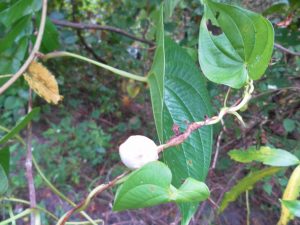
Photograph by J. Baniszewski
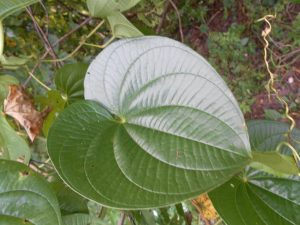
Photo by J. Baniszewski
Dioscorea bulbifera is a perennial monocot in the family Dioscoreaceae, also known as the Yam family (Plants Database, MacDonald et al. 2008). The vine is known for its dark-green heart shaped leaves that are arranged alternately (Invasive Plant Atlas). It can grow to be over 18 meters longs and primarily reproduces vegetatively via tubers or bulbils that are potato-like and grow at the axils of the leaves (Invasive Plant Atlas). These tubers are various in size. Large underground tubers may be up to six inches in diameter (MacDonald et al. 2008). D. bulbifera leaf veins start from the leaf base, which is a feature that aids in identifying this vine from others. Although flowers are not commonly present on the vines invading Florida, air-potato does have small flowers about four inches long from leaf axils (MacDonald et al. 2008).
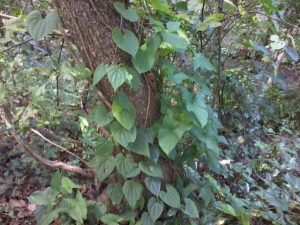
Management practices may include preventative measures, cultural, or chemical methods. Air-potato lacks a known biological control agent. Mechanical methods are limited due to the reproduction from small bulbils and damage to other natural vegetation (MacDonald et al. 2008).Spread can be prevented by simply being cautious and careful when removing vegetative cuttings or debris that may contain tubers or moving landscaping equipment without proper cleaning (MacDonald et al. 2008). It is speculated that air-potato primarily invades disturbed areas by transportation of the tubers after landscaping in one location and moving to another without cleaning equipment or moving soil or other cuttings. Because even very small tubers can sprout, spread by human transportation can be done easily and extra caution should be taken. Additionally, flowing water can easily carry and spread these bulbils (MacDonald et al. 2008). Chemical methods, like mechanical mechanisms, are hard to apply due to the tuber propagation. Triclopyr or glyphosate (Round-up) is recommended for killing the vegetative growth, but needs to be applied carefully to the vine so as to not kill other vegetation (MacDonald et al. 2008). Gainesville in Alachua county as well as Hernando and Duval counties have been actively removing the vine in city round-ups where volunteers remove the vine and tubers from natural areas. In 2003, Gainesville Parks and Recreation managed to collect 13 tons of air potato and other invasive plants with the help of volunteers (MacDonald et al. 2008).

Photo by J. Baniszewski
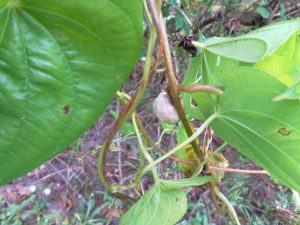
Photo by J. Baniszewski
Links:
http://www.invasiveplantatlas.org/subject.html?sub=3017
http://plants.usda.gov/core/profile?symbol=DIBU (Note: also shows county distributions of the vine.)
http://plants.ifas.ufl.edu/node/133
http://www.florida.plantatlas.usf.edu/Plant.aspx?id=1726
http://www.issg.org/database/species/ecology.asp?si=1220&fr=1&sts=sss&lang=EN